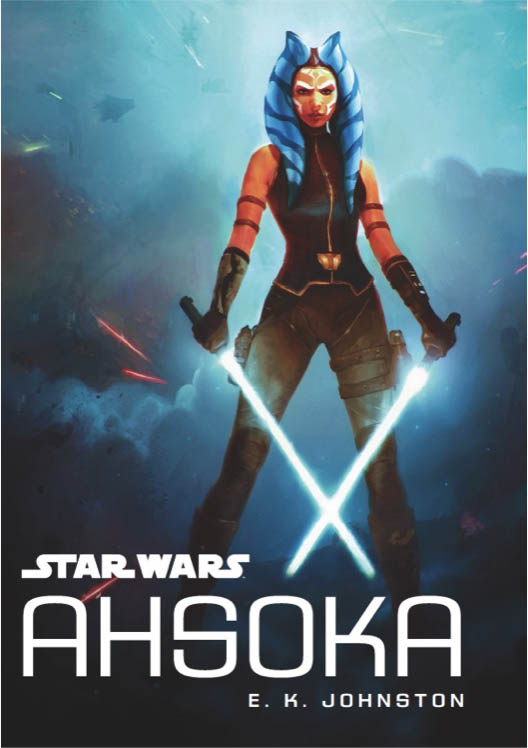Bria: Ever since Ahsoka Tano showed up as Fulcrum on Star Wars Rebels, fans have wanted to know what she’s been up to since she left the Jedi Order. Thanks to a brand new young adult novel by E.K. Johnston, we finally get our answer. Well, some of it. Ahsoka picks up a year after Order 66 with the former Jedi in hiding on a backwater planet but always on alert for the Empire.
The book starts out slow with the most intriguing bits being the brief flashes we get of the Siege of Mandalore and the direct aftermath of Order 66. Johnston takes her time establishing what Ahsoka’s life is like now. She’s a mechanic who makes as quiet of a life for herself as she can manage but still becomes attached to some of the people around her despite her best efforts. The story picks up once Bail Organa enters the picture and then races to its action packed conclusion.
Johnston does a good job of establishing her diverse cast which, awesomely has a ton of female characters at the forefront. This is a book that easily passes both the Bechdel and the Sexy Lamp Tests and shows capable ladies helping other capable ladies. Kaeden and Miara (two sisters on a farming planet) are distinct, likable characters who are good friends to Ahsoka, and Hedala Fardi is beyond adorable.
One of the book’s weaknesses is when it’s set. A single year post-Order 66 doesn’t feel like quite enough time has passed for the story the book is telling. Three or five years might have felt like it worked better. The book also cover a very short time frame so readers hoping for the definitive Ahsoka book that covers all the years between the Clone Wars and Rebels might be a little disappointed. The brief flashbacks scattered throughout help scratch that itch but also might make readers yearn even more to see the Siege of Mandalore.
Ahsoka is a fun, easy read that fans of the character will likely sincerely enjoy and leave them wanting more. It may not be the most jaw-dropping addition to the new canon but it’s definitely worth a reader’s time.
NancI: In short: what Bria said. Longer: Ahsoka is a hard book for me to review because, objectively, there’s nothing bad about it. It’s a well-written book with interesting characters and tells an important story within Star Wars canon. However, it takes place in a time period I don’t find very interesting and, like Bria said, when I was done reading I found myself wanting more. (That isn’t necessarily a bad thing for some reasons.)
I think part of my problem with the book was the scope. It spans a short period of time in Ahsoka’s life, shortly after Order 66. I always had the impression that Ahsoka became involved in the proto-rebellion much later than she did in the book. I didn’t mind this change, and I think Johnston deftly portrays why Ahsoka got involved so early, but I still would have liked to see Ahsoka’s relief efforts be a larger focus of the book. As it is, she spends most of the first half of the book on Raada, returns to Thabeska and starts her mercy missions, and is approached by Bail Organa not long after. The book sort of glosses over her missions, not to mention how she came to Bail Organa’s attention. Once Bail shows up about halfway through, the story really starts to move. (Perhaps that’s why some sections seemed glossed over, because the pacing picked up?)
I kept thinking back to another YA book, Lost Stars, which spans from the Dark Times, throughout entire Original Trilogy, and ended after the Battle of Jakku. By the end, I truly felt that I knew Thane and Ciena. I didn’t get that same feeling after reading Ahsoka. While I liked the story and love that she found a place among the Rebellion, I felt like the book could have spanned a much longer time frame so we could really get a sense of how Ahsoka evolved between The Clone Wars and Rebels. The definitive story of Ahsoka, if you will. The novel fits in well with what we know about her, but there are still a lot of missing pieces. Some of those make sense (Dave Filoni is saving the Siege of Mandalore for himself, probably), but I would have liked to see more of how Ahsoka dealt with the aftermath of leaving the Jedi Order and surviving Order 66. We see some glimpses of it, but I felt like Johnston could have dove deeper.
Still, I appreciate what Johnston set out to do here. She writes Ahsoka, and all the other characters, very well. I did a little fist pump when Bail Organa showed up and wish he’d been in the book more. (Also, she writes a great Artoo and I could almost sense her absolute joy writing him whenever he was on the page.) I also loved how she wrote about Alderaan (and still wish for a book or show that takes place entirely on that planet because I’m a masochist).
In the end, Ahsoka is an enjoyable read and is definitely recommended for fans of Ahsoka Tano.


